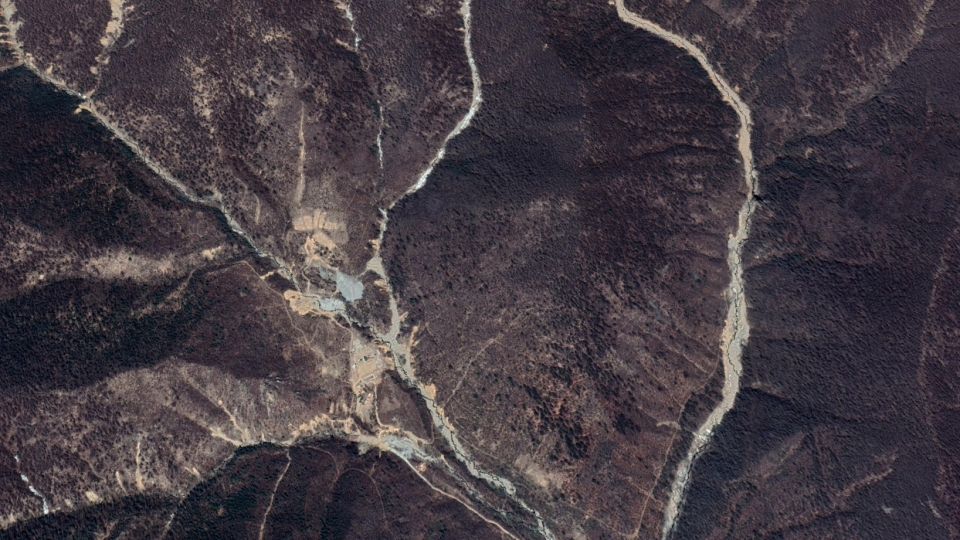August 31, 2022
SEOUL – North Korea appears to have temporarily stopped work to reactivate an unused tunnel at the Punggye-ri nuclear testing site, likely due to recent heavy rains, a Washington-based think tank said Monday.
Commercial satellite images acquired on Aug. 24 indicated that road construction to Tunnel No. 4 remained suspended at North Korea’s main nuclear testing site in Punggye-ri in Kilju County of North Hamgyong Province, the CSIS Korea Chair, which runs the Beyond Parallel project, said in an online report.
In June, the think tank revealed that new construction activity had been observed in the vicinity of Tunnel No. 4, which is also known as the West Portal, to potentially reenable it for nuclear testing.
But the CSIS Korea Chair said Monday that satellite images on Aug. 24. did not show any significant construction activity such as rebuilding the access road and associated retaining wall leading to the collapsed portal to Tunnel No. 4.
“Road construction to Tunnel No. 4 remains suspended, and flood damage to the facility’s sole access road is observable, both likely a result of the heavy rains during the past two months,” it said.
“What appears to be some minor changes to the riverbed due to recent heavy rains are noted within the streambed to the east of the access road and portal.”
In the satellite imagery, no vehicle, equipment or personnel were spotted in the area around Tunnel No. 4.
The CSIS Korea Chair pointed out that construction below the collapsed portal for Tunnel No. 4 may aim to expand North Korea’s nuclear testing capabilities. But it also reiterated that the Kim Jong-un regime may seek to deceive the international community by carrying out unnecessary construction.
North Korea also constructed a new bypass connecting the command center of the Punggye-ri nuclear testing site to the nearby support facility between late July and early August, adding to the sole existing road linking the two areas.
The US think tank explained that building the road was “undoubtedly due to the recent heavy rains and resulting flooding.”
The original road section is susceptible to flooding and affected by even minor storms, given that it ran along the sides of the riverbed and crossed the Changuk Stream four times through bridges.
But in contrast, the 740-meter-long, newly built road runs on the west side and slightly above the Changuk Stream.
“The new section should provide unobstructed access to the command center during future flooding events,” the CSIS Korea Chair said.
Satellite images on Aug. 24 also did not show any new activity of significance in the area around the restored portal for Tunnel No. 3 compared to images from June. No vehicles, equipment or personnel were observed in the sector.
“This is not unexpected as both the United States and South Korea assess that North Korea has finished all preparations for conducting a nuclear test at this tunnel,” the CSIS Korea Chair said in the report.
During a parliamentary briefing, South Korea’s Defense Minister Lee Jong Sup also said Monday that North Korea is capable of conducting a nuclear test at Tunnel No. 3, but there have been no “peculiar signs” in the area.
Previous commercial satellite imagery suggested that North Korea had resumed reactivation activity at the Punggye-ri nuclear test site since early March.
Such activity was detected for the first time since North Korea dismantled the nuclear testing site in May 2018 ahead of the first US-North Korea summit in Singapore to implement North Korean leader Kim Jong-un’s commitment at a party plenum.
North Korea conducted six nuclear tests between 2006 and 2017 at the country’s sole nuclear test facility in Punggye-ri.
Pyongyang used Tunnel No. 1 for its first nuclear test in October 2006 and Tunnel No. 2 for its other five nuclear weapons tests carried out between May 2009 and September 2017. But it has not yet conducted any nuclear tests using the remaining two tunnels to date.


